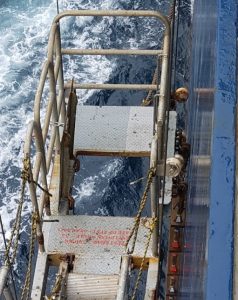The Charity
Aviation
Maritime
Ships that feature in multiple reports

Initial Report
Occasionally a ship features in more than one report, sometimes about a single issue and on other occasions about different issues.
Recently CHIRP received three reports about a single ship from different reporters at different locations but concerning the same issue. It would appear that some ships do not (or will not) learn.
A second vessel was the feature of two reports, again by different reporters at different locations, but about different issues. At first reading, this does not look good, but at least the second report closed out the first deficiency which demonstrates that some vessels do try to rectify their defects.
Vessel One: A vessel which, due to its freeboard, is required to use a combination pilot boarding arrangement. The arrangement is a trap door-type combination.
What the reporter told us (1):
Upon boarding as a pilot, I noted that the man ropes were rigged incorrectly and that the pilot ladder was not attached to the ships side 1.5m above the accommodation ladder platform. The vessel has a trap door arrangement with the pilot ladder shackled under the platform, but this is non-compliant. As this vessel is likely to be regularly calling at this and other ports on the coast, the issue needs to be resolved as soon as possible to avoid future refusal of pilotage services and to remove the risk to pilots. Report dated 05th April.
What the reporter told us (2):
This vessel presented herself for pilot boarding on the 18th May with the following defects.
- The man ropes are too small being less than 28mm in diameter.
- The pilot ladder is not attached to the ships side 1.5m above the accommodation ladder platform.
- The trap door combination ladder arrangement is not compliant.
What the reporter told us (3):
The pilot ladder not attached to the ships side 1.5m above the accommodation ladder platform. Although I safely boarded the vessel using the starboard side ladder it was noted that the trap door arrangement was non-compliant.
Report dated 01st July
CHIRP made two attempts to contact the vessel’s DPA, but our attempts to engage in correspondence did not receive any acknowledgement or response.

Non-compliant combination boarding arrangement with the pilot ladder shackled to the underside of the accommodation ladder platform.
Vessel Two: A vessel whose size and freeboard allows it to use a direct pilot ladder as opposed to a combination arrangement.
What the reporter told us (1):
On this vessel the starboard pilot ladder was noted to be old and very worn, with both side ropes chafed and flattened. The ladder steps were slippery with Palm Kernel Expeller cargo. There was no visible construction plate attached to the ladder. The tripping line was rigged to the aft side of the ladder instead of being led forward. I requested that this ladder be replaced before the vessel’s departure.
Report dated 24th May.
What the reporter told us (2):
As a follow up to a previous pilot ladder report (as highlighted above) I boarded this vessel using the port side ladder which was in a satisfactory condition. The master advised me that the starboard ladder had been condemned and that a new ladder had been ordered. This was expected to be delivered when the vessel arrived alongside.
Report dated 29th May
These two reports highlight evidence that some ships do take heed of deficiency reports and take positive action to rectify the issue. This is encouraging and is to be applauded.
CHIRP Comment:
After considerable discussion, the Maritime Advisory Board members noted the following points;
- Pilot ladders and combination arrangements are one of the visible faces of SOLAS. Pilot ladders and other pilot boarding arrangements come under the SOLAS regulations and are no less vital for safety than lifeboats, liferafts and lifebuoys. If the condition of the pilot ladders featured in these reports is indicative of the other SOLAS equipment on board it does not bode well in the event of having to abandon ship.Similarly, the safe and compliant rigging of the pilot boarding arrangements on board a ship is comparable to the ability of the crew to launch a lifeboat or liferaft.
- The reports that CHIRP publishes relating to pilot boarding arrangements are a small sample of the numerous reports received on the subject. Virtually every report received includes the phrase “Spoke to the master”, but this does not appear to be reducing the number of deficiencies and reports. Perhaps it is time for pilots to become more formal and issue a standard Letter of Non-Compliance to the master of the vessel. This can be achieved through the vessel’s agents and as such can be directed both to the vessel and the vessel’s managers.
- The issuance of such a letter would be a matter to be passed on to the local port state control office for relay to the flag administration of the vessel, thereby becoming a form of alerting.
- Pilots have the right to refuse to use non-compliant boarding arrangements but that still puts the onus on pilots to make that decision. Perhaps it is time for the national maritime authorities to issue directives instructing pilots not to use visibly non-compliant pilot boarding arrangements.
- These reports also raised the question as to what role CHIRP should take with regard to reports received. CHIRP has always followed a course of promulgating to the wider maritime readership with a view to informing and educating. However, in certain situations, is there a case for us to inform maritime authorities and administrations?
Further reading: There is a lot of material in CHIRP Insight articles which may be found on the publications page of our website – https://www.chirpmaritime.org/publications/
Report Ends.







